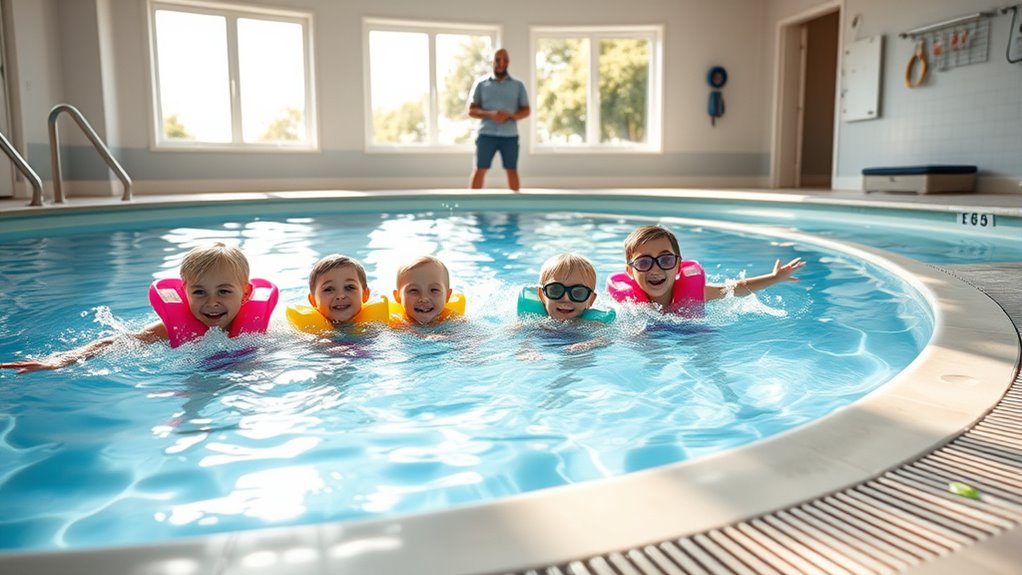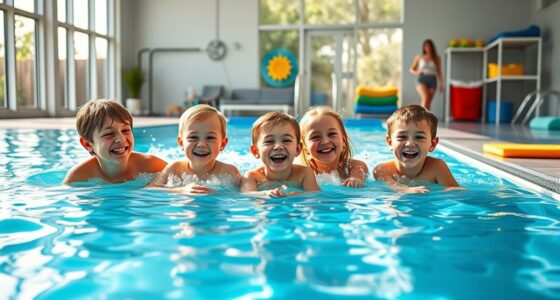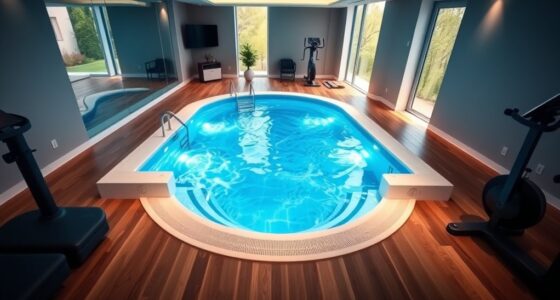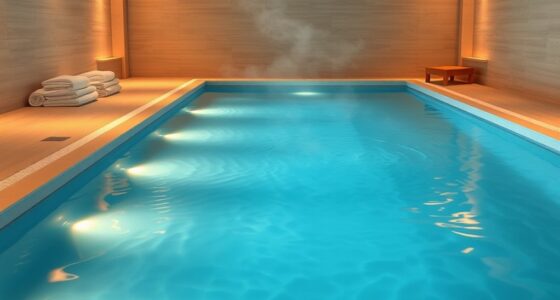To keep kids safe around an endless pool, always supervise them closely and never leave them unattended. Install a secure barrier or cover to prevent unauthorized access, and keep the area clutter-free when not in use. Use a locking gate and teach your children basic water safety and swimming skills early. Regularly inspect safety devices and avoid pool use during bad weather or when you’re alone. Stay informed to learn more safety tips that could help prevent accidents.
Key Takeaways
- Always supervise children actively and within arm’s reach when they are in or near the Endless Pool.
- Install and regularly inspect safety barriers, such as fencing and self-latching gates, to prevent unsupervised access.
- Teach kids water safety rules, including no running, diving, or swimming alone in the pool area.
- Keep rescue equipment and a phone nearby for quick emergency response.
- Avoid using the pool during bad weather or when tired, and ensure proper lighting for safe use.
Always Supervise Children Closely When They Are in or Around the Pool

Children can drown quickly and quietly, so you must always keep a close eye on them when they’re in or near the pool. Never leave children unattended, even for a moment. Constant supervision is essential, especially when they’re swimming or playing nearby. Stay within arm’s reach and avoid distractions such as your phone or conversations. Watch for signs of fatigue, distress, or discomfort, and be ready to intervene at any moment. Remember, pools like the Endless Pool can be tempting, but safety comes first. Make supervision a continuous, active process—don’t rely on others or assume someone else is watching. Your attentive presence can prevent a tragedy and ensure your kids enjoy the water safely. Understanding supervision guidelines can help prevent accidents and keep children safe around pools.
Install a Secure Barrier or Cover to Prevent Unauthorized Access
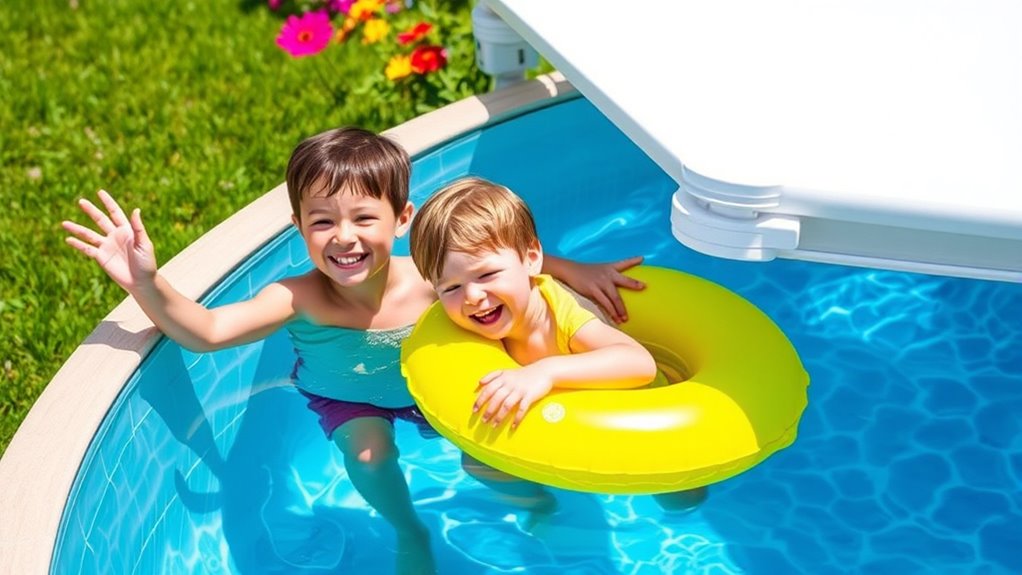
Installing a secure barrier or cover around your Endless Pool is one of the most effective ways to prevent unauthorized access and reduce the risk of accidental drownings. A sturdy, self-latching gate or fence creates a physical obstacle that keeps children from entering the pool area unsupervised. Consider installing a pool cover that’s strong enough to support weight, so kids can’t crawl under or remove it easily. Make sure the barrier is at least four feet high and locks securely when not in use. Regularly inspect the fencing and covers for damage or wear, replacing them as needed. These measures give you peace of mind, ensuring that your pool remains a safe environment when children are nearby or when you’re not actively supervising. Incorporating smart safety strategies can further enhance pool safety by utilizing data-driven solutions and regular safety assessments.
Keep the Pool Area Clear of Toys and Clutter When Not in Use
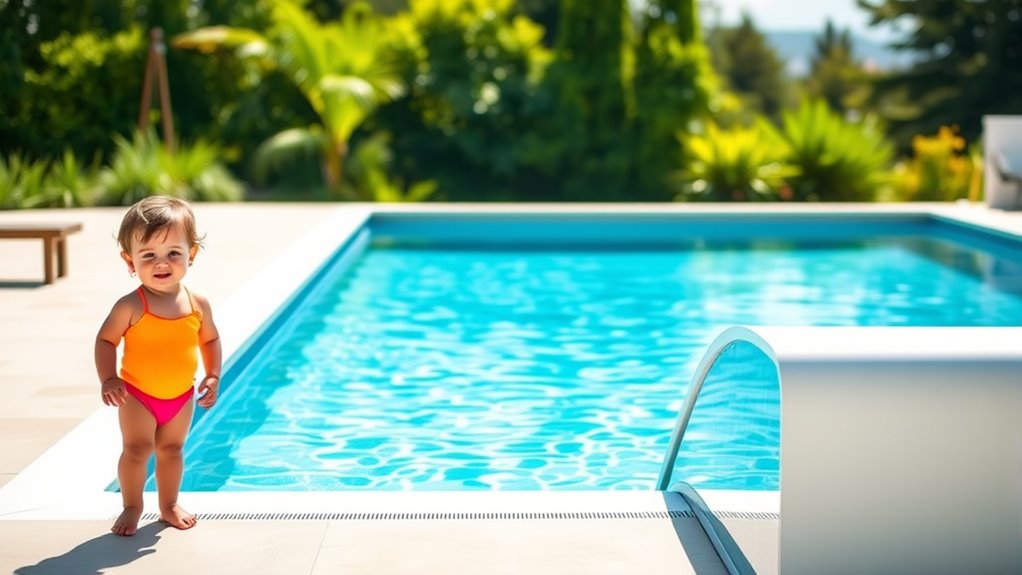
Keeping the pool area tidy helps prevent accidents and injuries. Use designated storage spaces for toys and equipment when the pool isn’t in use to keep the area safe. Make it a habit to do a regular cleanup to stay organized and minimize hazards. Additionally, incorporating proper lighting can improve visibility and safety around the pool area during evening hours.
Designated Storage Spaces
Ensuring the pool area remains safe and accessible means establishing designated storage spaces for toys and clutter when the pool isn’t in use. You should assign a specific bin, shelf, or container to keep all pool toys, floaties, and equipment organized. This prevents items from cluttering the deck or falling into the water unexpectedly, reducing tripping hazards. Make sure the storage area is easily accessible to you and your kids, encouraging them to return toys after use. Keep these spaces clean and dry to avoid mold or damage. By having a dedicated storage spot, you create a safer environment and encourage responsible behavior around the pool. Regularly check the storage area to ensure it remains tidy and that no toys are left out that could pose a risk. Additionally, consider using sustainable materials for storage containers to promote eco-friendly practices.
Regular Cleanup Routine
To maintain a safe and tidy pool area, it’s essential to establish a regular cleanup routine that keeps toys and clutter away when the pool isn’t in use. Make it a habit to gather all toys, floaties, and equipment immediately after swimming. Store them in designated containers or storage spaces to prevent tripping hazards. Regularly inspect the area for any sharp or broken items that could harm children. Encourage kids to put away their belongings themselves, fostering responsibility and safety awareness. Keeping the pool area clear reduces the risk of accidents and makes cleaning easier. Establishing this routine guarantees the space remains safe, organized, and ready for the next use, promoting a safer environment for everyone. Incorporating safety inspections into your routine ensures potential hazards are identified and addressed promptly.
Use a Locking Gate or Door to Restrict Access to the Pool Area
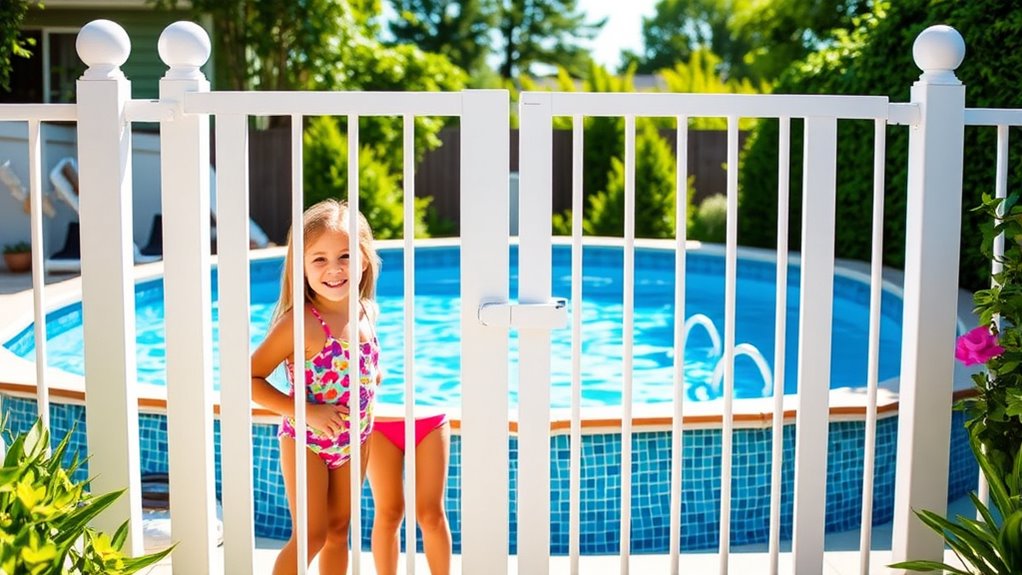
Using a locking gate or door to restrict access to the pool area is one of the most effective safety measures you can take. It prevents children from entering unsupervised and reduces accidental drownings. Make sure the gate or door is sturdy and self-closing to deter curious kids. Regularly check that the lock works properly and isn’t easily bypassed. Position the gate at an appropriate height, out of children’s reach, and avoid using locks that kids can easily open. Additionally, consider adding an alarm that sounds if the gate is opened unexpectedly. These precautions help guarantee that your pool area remains secure, giving you peace of mind while your children enjoy their time safely. Understanding contrast ratio helps you choose the right projector setup to ensure clear and vibrant visuals during family movie nights.
Teach Kids Basic Water Safety and Swimming Skills Early
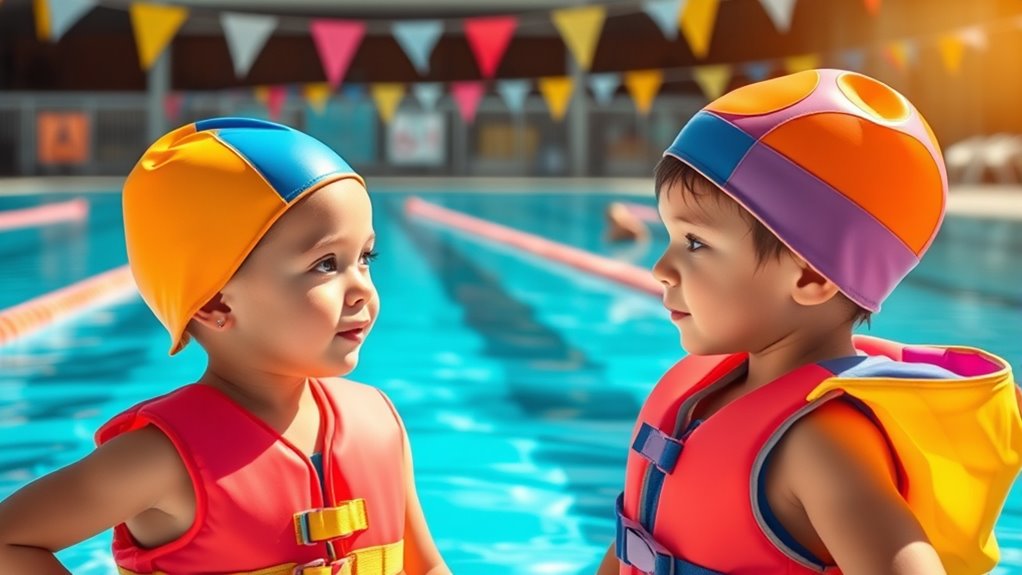
Teaching kids basic water safety and swimming skills early builds a strong foundation for their safety around pools and water. Start by enrolling your child in age-appropriate swimming lessons with certified instructors. Focus on teaching them to float, tread water, and recover from submersion. Make sure they understand how to recognize water hazards and the importance of staying within designated swimming areas. Encourage consistent practice to build confidence and competence. Explain the dangers of swimming alone or in unsupervised areas. Reinforce that water safety isn’t just about swimming well; it’s about understanding water risks and respecting the pool environment. Incorporating educational toys and activities that promote water safety and water-related skills can further enhance their understanding and confidence. By instilling these skills early, you help your child develop safe habits that can prevent accidents and ensure they enjoy water activities responsibly.
Never Rely on Pool Alarms Alone for Safety

You shouldn’t rely solely on pool alarms to keep kids safe, because alarms can fail unexpectedly. Constant supervision is essential to catch any situations before they become dangerous. Using multiple safety measures ensures better protection around your Endless Pool. Incorporating essential oils for safety into your safety routine can provide additional peace of mind.
Alarm Failures Occur Frequently
Pool alarms can provide a false sense of security because they often fail when you need them most. You shouldn’t depend solely on these devices to keep your kids safe. Alarm failures can happen for various reasons, putting your child at risk. To reduce danger, consider these important points:
- Regularly test alarms to ensure they work properly.
- Keep alarms clean and free of debris that can block sensors.
- Use alarms as a supplement, not a substitute, for supervision.
- Always double-check that alarms are armed and functioning before pool use.
- Remember that angel numbers can serve as spiritual reminders to stay vigilant and prioritize safety around water.
Constant Supervision Essential
While pool alarms can alert you to some emergencies, they shouldn’t be your only line of defense. You must actively supervise your kids whenever they’re in or near the pool. Never leave children unattended, even for a moment. Constant supervision means watching them closely, staying engaged, and being prepared to step in immediately if needed. Kids can quickly get into trouble, and alarms can fail or be triggered accidentally. Relying solely on alarms creates a false sense of security. Your presence and attentiveness are essential to keeping your children safe. Make sure an adult is always within arm’s reach or at least nearby to respond instantly. Vigilance is your best tool to prevent accidents and ensure a safe swimming environment. Additionally, understanding the importance of Constant supervision can significantly reduce the risk of incidents.
Multiple Safety Measures Needed
Relying solely on pool alarms isn’t enough to keep kids safe. You need multiple safety measures to create a secure environment. First, install a lockable gate around the pool area to prevent unsupervised access. Second, always keep a close eye on children when they’re near or in the water. Third, consider using a cover or pool safety fence to add an extra layer of protection. Fourth, teach your kids water safety rules and ensure they understand the importance of staying within safe boundaries. Combining these measures reduces risks considerably. Remember, alarms can fail or be ignored, so don’t rely on them alone. A thorough safety approach is essential for keeping your kids safe around your Endless Pool.
Set Clear Rules for Pool Use and Make Sure Kids Understand Them

To guarantee kids stay safe around the Endless Pool, it’s essential to establish clear rules for pool use and make sure they understand them thoroughly. Explain the rules simply and directly, such as no running around the pool, no diving unless supervised, and always staying within arm’s reach if they’re young. Consistently reinforce these guidelines so they become second nature. Use visual cues like signs or color-coded zones to highlight safety boundaries. Talk through scenarios they might encounter and remind them of the importance of following the rules at all times. Make sure your kids know that breaking these rules can lead to serious accidents. By setting firm, understandable boundaries, you help keep your kids safe and promote responsible pool behavior.
Keep Rescue Equipment and a Phone Nearby at All Times

Keeping rescue equipment and a phone nearby is an essential part of maintaining a safe pool environment. You never know when an emergency might happen, so being prepared is vital.
Staying prepared with rescue gear and a phone is key to pool safety.
- Keep a life ring, reaching pole, or floatation device within arm’s reach, ready to assist a struggling swimmer.
- Place a waterproof phone case near the pool or in a designated safety station for quick access.
- Ensure the phone is charged and has emergency contacts saved for immediate use.
- Regularly check that rescue equipment is in good condition and easily accessible.
Having these items nearby allows you to respond swiftly and effectively, reducing potential risks and ensuring everyone’s safety around the pool.
Regularly Inspect and Maintain Pool Safety Devices and Barriers
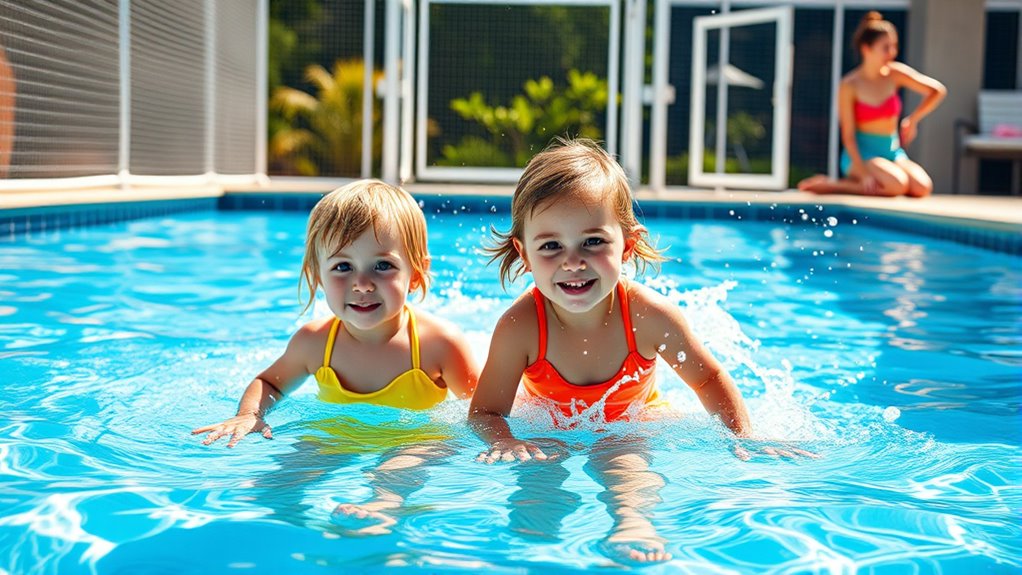
You need to regularly check your pool safety devices and barriers to guarantee they work properly. Look for signs of wear and tear, test safety alarms often, and make sure barriers stay secure. Staying proactive helps keep your kids safe around the pool at all times.
Check for Wear and Tear
Regularly inspecting your pool safety devices and barriers is essential to guarantee they function properly and keep kids safe. Over time, wear and tear can compromise their effectiveness. You should:
- Check for cracks, rust, or corrosion on gates, latches, and fences.
- Examine safety covers for tears, holes, or frayed edges.
- Inspect pool alarms and sensors for any damage or malfunction.
- Ensure that safety signage remains visible and intact.
If you notice any damage or deterioration, repair or replace the affected parts immediately. Don’t overlook small issues—they can quickly become safety hazards. Maintaining these devices ensures they work reliably, giving you peace of mind that your kids are protected when around the pool. Regular upkeep is your best defense against potential accidents.
Test Safety Alarms Regularly
Since safety alarms are essential for alerting you to potential dangers, testing them regularly guarantees they function correctly when needed most. You should activate each alarm according to the manufacturer’s instructions, making sure it sounds clearly and loudly. Check that sensors are clean and unobstructed, and replace batteries at least once a year or as recommended. Regular testing helps catch malfunctions before an emergency occurs. Keep a schedule to remind yourself to perform these tests weekly or monthly, depending on your alarm’s specifications. If an alarm fails to sound or shows signs of damage, replace it immediately. Properly functioning safety alarms provide peace of mind by alerting you instantly if a child enters the pool area unexpectedly. Consistent testing keeps your safety system reliable and effective.
Keep Barriers Secure
Keeping pool barriers secure is essential for preventing unsupervised access and ensuring safety. Regular inspections help spot potential weaknesses before accidents happen. You should:
- Check for loose or damaged latches and locks, repairing or replacing them immediately.
- Ensure gates close automatically and latch securely without gaps.
- Inspect fencing for rust, cracks, or holes that could allow kids to slip through.
- Test safety devices like alarms and sensors to confirm they activate correctly.
Avoid Pool Use During Bad Weather or When Alone
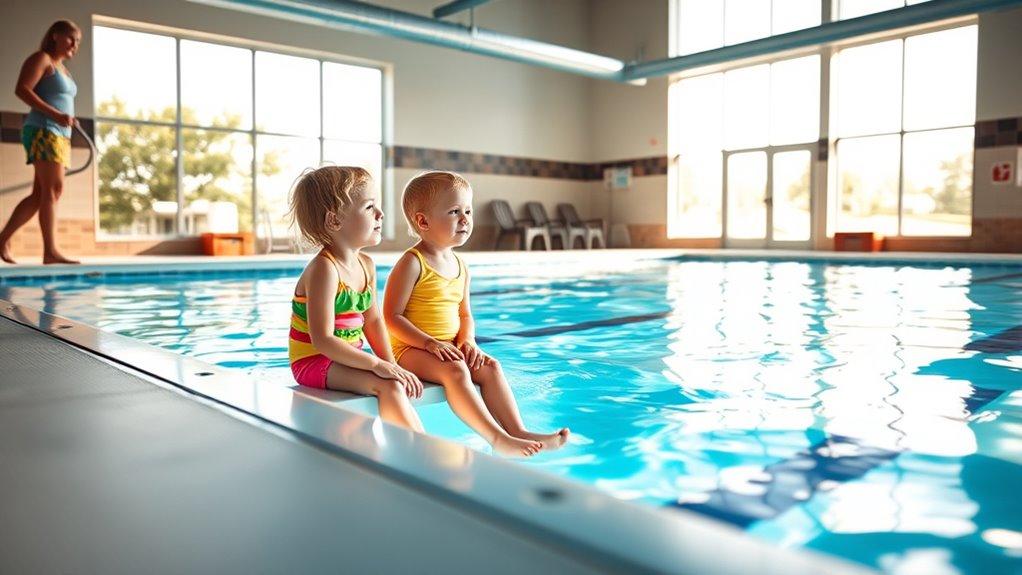
Avoid swimming in the pool during bad weather or when you’re alone. Storms, lightning, or heavy rain can turn your pool into a danger zone quickly. Being alone increases the risk if an emergency occurs. Always wait for clear skies and safety signals before swimming again. Use this guide to recognize unsafe conditions:
| Weather Condition | Risk Factors | Parent Action |
|---|---|---|
| Thunderstorms | Lightning strikes, power loss | Keep kids out until storm passes |
| Heavy Rain | Reduced visibility, slippery surfaces | Avoid entering the pool |
| Strong Winds | Debris, instability | Ensure area is clear |
| Cold Temperatures | Hypothermia risk | Do not swim in cold weather |
| Alone | No immediate help available | Supervise or wait for company |
Educate Children About Pool Hazards and Safe Behavior
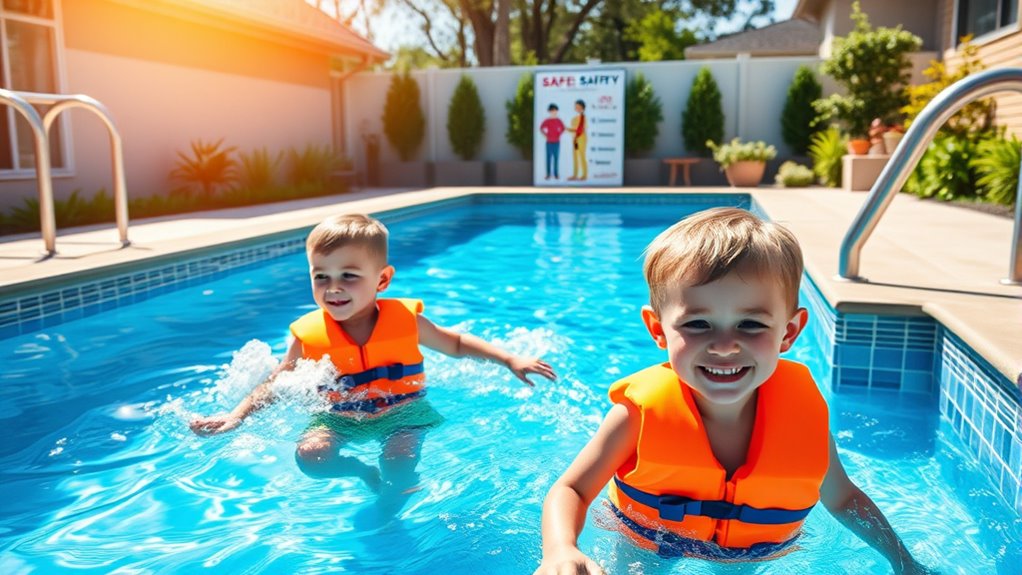
Teaching children about pool hazards and safe behavior helps prevent accidents and guarantees they understand the importance of staying safe around water. Start by explaining the dangers clearly, so they recognize risks. Make sure they know never to run or push near the pool to avoid slips and falls. Teach them to always swim with a buddy and stay within designated areas. Emphasize the importance of obeying safety rules and listening to adult instructions. Finally, remind them that only qualified supervision is allowed when they’re in or around the pool. By instilling these lessons, you help your kids develop safe habits that protect them and promote responsible water behavior. Proper education is key to creating a safe, enjoyable swimming environment for everyone.
Model Safe Water Practices and Responsible Supervision
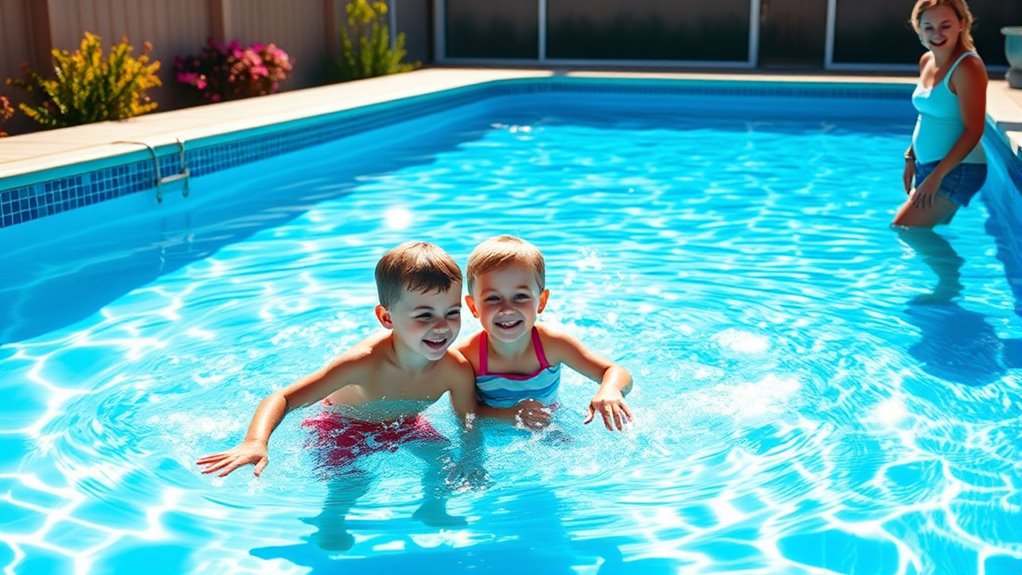
Modeling safe water practices and providing responsible supervision are essential for preventing accidents around the pool. Always demonstrate proper pool behavior, such as not running, pushing, or roughhousing near the water. Show children how to enter and exit safely, and emphasize the importance of staying within designated areas. Keep a close eye on your kids at all times, avoiding distractions like phones or conversations. Make sure they understand they should never swim alone, even in shallow water. Use a designated supervisor if you’re busy or need a break. Your active involvement reinforces safe habits and helps children understand that water safety is a priority. Consistent supervision and leading by example create a safer environment for everyone.
Frequently Asked Questions
How Can I Teach My Child to Swim Confidently and Safely?
To help your child swim confidently and safely, start with consistent lessons and positive reinforcement. Always supervise closely and make sure they understand water safety rules. Use an Endless Pool to build skills gradually in a controlled environment. Encourage practice, stay patient, and celebrate progress. Teach them to float, tread water, and recognize their limits. With time, your child will gain confidence and develop strong, safe swimming habits.
What Should I Do if My Child Is Missing Near the Pool Area?
If your child is missing near the pool, act quickly but calmly. Immediately scan the area, calling their name calmly. Alert any nearby adults or lifeguards and instruct them to help search. Check common hiding spots or places they might have gone. Don’t forget to turn off the pool’s pump to avoid noise interference. Stay focused, keep your composure, and act swiftly—every second counts in ensuring their safety.
Are There Specific Safety Tips for Very Young Children Around Pools?
You should always keep very young children within arm’s reach when they’re near the pool, never leave them unattended, and install secure barriers like fences with self-latching gates. Constantly supervise them, even if they’re just near the water for a moment. Use pool alarms and teach them basic water safety skills early. Remember, vigilant supervision and physical barriers are your best defenses against accidents.
How Often Should I Check and Maintain Pool Safety Devices?
You should check and maintain your pool safety devices weekly to make certain they’re working properly. Test alarms, inspect fences, and verify covers are secure. Keep a routine to clean and replace batteries in alarms, tighten any loose hardware, and confirm that safety gates latch correctly. Regular maintenance creates a safe environment, giving you peace of mind. Staying vigilant helps prevent accidents and keeps your kids protected around the pool.
What Are the Signs That Indicate My Child Is Ready to Learn Swimming?
You’ll know your child is ready to learn swimming when they show interest in water, can follow basic instructions, and exhibit comfort around the pool. Look for signs like curiosity, the ability to hold their breath, and some independence in water activities. Make certain they’re confident enough to listen and stay calm in the water, which indicates they’re prepared to start swimming lessons safely and effectively.
Conclusion
By following these safety rules, you create a fortress of protection around your kids, turning the pool into a safe haven rather than a hidden danger. Remember, your vigilance is the lighthouse guiding them safely through water adventures. With constant supervision, proper barriers, and teaching good habits, you’ll help your children enjoy the endless pool fun without risking their safety. Stay alert, stay prepared, and watch their smiles grow as safely as the waves.
